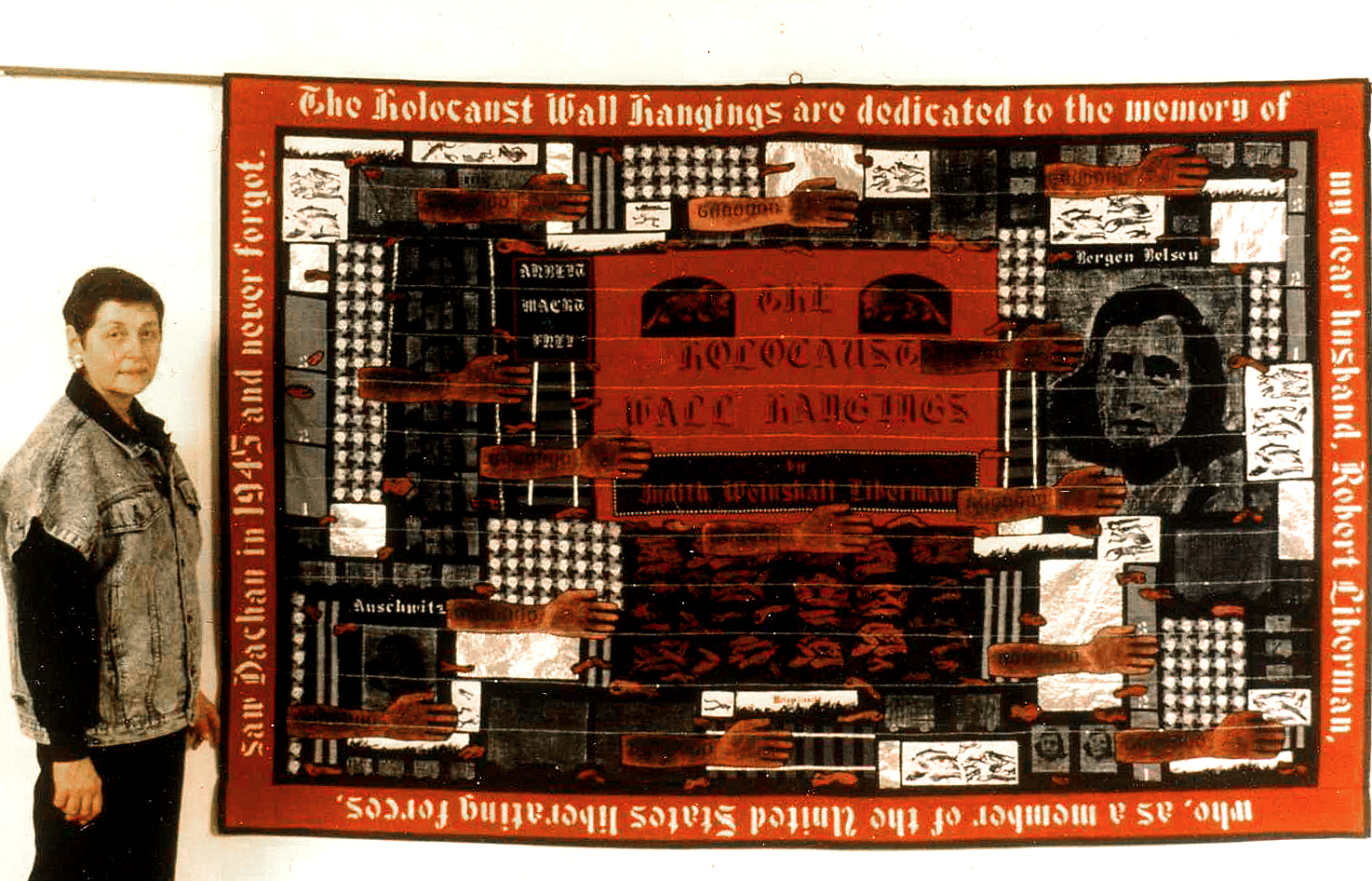The Holocaust Wall Hangings
Judith Weinshall Liberman
View the February 2017 Discussion on the Holocaust Wall Hangings: Anne Frank Series Video
View The Holocaust Wall Hangings Video
View the Biblical History Wall Hangings Video January 2019
Return to the Holocaust Wall Hangings Gallery
Detailed Annotations of Each Holocaust Wall Hanging
In 1988 I began creating the Holocaust Wall Hangings. By then I had already completed a series of more than two dozen paintings about the Holocaust. The paintings had been done in acrylics and incorporated brush painting, block printing and stenciling. I felt that the medium I had used – paint on stretched canvas – could not fully convey my feelings about the Holocaust.

By using fabric as a background – and the Holocaust Wall Hangings are works on fabric – I could extend the size of the works and harness a wide variety of means to express myself. I could paint on the fabric, and do block printing and stenciling, as I had done in the paintings; but I was able to introduce sewing, applique, embroidery and beading as well. The resulting surfaces and textures, added to those of the background fabric itself, broadened my means of expression far beyond what was possible in the paintings. The loose-hanging fabric promised to be significant in itself by evoking an image of banners of the Third Reich, which flew over Europe during the Holocaust.
In the Holocaust Wall Hangings, as in most of my work, color is used expressively rather than descriptively. To convey my feelings about the Holocaust, I found it necessary to employ a limited palette of red, gray and black. The choice seemed inevitable: red - blood and fire; gray - suffering and despair; black - death.
Like my Holocaust Paintings, the Holocaust Wall Hangings abound with repeated images: a body, a dismembered arm, a boxcar reappears in the same work. The repeated images are usually done by means of block printing. For some works, dozens of blocks are carved with similar (though not identical) images. The repetition of images is designed to underscore the relentlessness of the Holocaust.
The Holocaust Wall Hangings fall mainly into two distinct groups: First, there are the Scenes of the Holocaust. These works refer more or less to the visible world; in the continuum between realistic and abstract they are closer to the former than to the latter. In these works people take center stage. They are seen as either utterly isolated or as part of a totally depersonalized mass. In either situation the individual is portrayed as stripped of his/her humanity by the Holocaust.
In the second group, the Maps of the Holocaust, the Holocaust is depicted in more abstract terms. Places and numbers, as well as other symbols of destruction, here take the place of the individual in telling the story. Often in these works, as in the Scenes, people appear, but this is done within the broader context of place and time.
The Holocaust Paintings had already consisted of Scenes on the one hand and Maps on the other. Although there were new Scenes and Maps to construct, my main task in creating the Holocaust Wall Hangings was, as I saw it, to maximize the power of my new medium in conveying my vision of the Holocaust.
After spending a decade creating artwork – both paintings and wall hangings - about the Holocaust, I began exploring my personal relationship with the subject of the Shoah. This I did in a series of mixed media works (combining collage and painting) called Self-Portraits of a Holocaust Artist, in which I placed myself in Holocaust settings as an act of empathy with the victims. Some of these works were later translated into Holocaust Wall Hangings. I called the sub-series Epilogue. Also included in this sub-series are wall hangings raising an artist's post-Holocaust questions about God. The Epilogue wall hangings thus express in a more direct way than the Scenes and Maps my personal feelings and thoughts about the Holocaust.
It is reasonable to assume that but for the indelible impression that the war years made upon me, I would not be focusing my work on the Holocaust today. But there are probably other factors as well. One need not be a psychologist to realize that an artist's work has deep psychological roots; the choice of subject matter is rarely a conscious one for an artist. In the final analysis, however, it is not what drives me to create the Holocaust Wall Hangings that is important. What is important is that my Holocaust art, standing on its own independently of its creator, will speak to people's hearts. What is important is that tomorrow, one year from now, ten years from now, a hundred years from now someone somewhere contemplating the Holocaust Wall Hangings will be moved enough to look into his/her own heart and resolve to be human.
SONGS ABOUT THE HOLOCAUST:
LIKE SHEEP TO THE SLAUGHTER (From the musical "To Be An Artist")
![]() Listen
Listen
![]() Read the lyrics
Read the lyrics
RED, GRAY, AND BLACK (From the musical "To Be An Artist")
![]() Listen
Listen
![]() Read the lyrics
Read the lyrics





